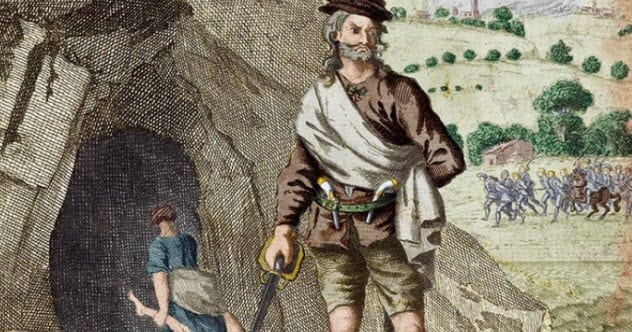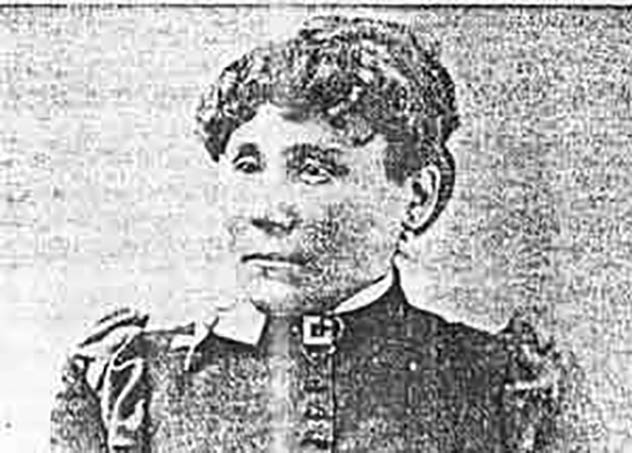 Movies and TV
Movies and TV  Movies and TV
Movies and TV  History
History 10 Things You Didn’t Know About the American National Anthem
 Technology
Technology Top 10 Everyday Tech Buzzwords That Hide a Darker Past
 Humans
Humans 10 Everyday Human Behaviors That Are Actually Survival Instincts
 Animals
Animals 10 Animals That Humiliated and Harmed Historical Leaders
 History
History 10 Most Influential Protests in Modern History
 Creepy
Creepy 10 More Representations of Death from Myth, Legend, and Folktale
 Technology
Technology 10 Scientific Breakthroughs of 2025 That’ll Change Everything
 Our World
Our World 10 Ways Icelandic Culture Makes Other Countries Look Boring
 Misconceptions
Misconceptions 10 Common Misconceptions About the Victorian Era
 Movies and TV
Movies and TV The 10 Coolest Stars to Set Sail on The Love Boat
 History
History 10 Things You Didn’t Know About the American National Anthem
 Technology
Technology Top 10 Everyday Tech Buzzwords That Hide a Darker Past
Who's Behind Listverse?

Jamie Frater
Head Editor
Jamie founded Listverse due to an insatiable desire to share fascinating, obscure, and bizarre facts. He has been a guest speaker on numerous national radio and television stations and is a five time published author.
More About Us Humans
Humans 10 Everyday Human Behaviors That Are Actually Survival Instincts
 Animals
Animals 10 Animals That Humiliated and Harmed Historical Leaders
 History
History 10 Most Influential Protests in Modern History
 Creepy
Creepy 10 More Representations of Death from Myth, Legend, and Folktale
 Technology
Technology 10 Scientific Breakthroughs of 2025 That’ll Change Everything
 Our World
Our World 10 Ways Icelandic Culture Makes Other Countries Look Boring
 Misconceptions
Misconceptions 10 Common Misconceptions About the Victorian Era
10 More Famous People Who Never Existed
There is something a bit weird about company mascots, folk figures and cartoon characters. You get to know them, care for them and, if you have too much time and an overactive childhood-reclamation gland, a feverish need to write fan fiction about them. This list includes some unreal characters that people swear blind actually exist. Spoiler alert—they don’t…probably.
Top 10 Famous People Who Never Existed
10 Mavis Beacon

Plenty of people reading this will be thinking “Of course, she’s a mascot, who thought she was real? I mean everyone knows Betty Crocker isn’t real, right?” Well, that would be the people who are reading and thinking “Whaaaaat?! Noooooo!”
Mavis Beacon, the lady who adorns the packaging for popular typing software, is another fabrication from the corporate world with a racially-charged past (Like ‘Uncle Ben’ and ‘Aunt Jemima’). Due to the mascot being modeled by a Haitian-American lady named Renée L’Espérance (who had been scouted from the perfume kiosk at Saks, Fifth Avenue in New York), many retailers were reluctant to stock the product. The product has been used to teach millions of school children to type since 1987, in the same way as the careful tutelage of Professor Rosetta Stone taught me to speak Spanish…[1]
9 N. Senada—The Bavarian Musical Genius
Very little is ‘known’ about the avant-garde music collective ‘The Residents’. Plenty of lore, theories and recordings exist of course, but none of this answers key questions people may have; questions like—”Who are The Residents?” Well, we know that Texan musician Hardy Fox was a founding member. That’s about it.
One notable collaborator is Bavarian composer and theorist N. Senada, originator of the ‘Theory of Obscurity’ and the ‘Theory of Phonetic Organization’. So far, so impressive. But, much like anything in the extended universe of ‘The Residents’, this man who should be a world famous composer with reams of articles about him, an in-depth bio and maybe even a documentary or two charting his rise. Nope. Some have joined up some floating, elusive dots and have surmised that N.Senada was probably Don Van Vilet (better known as Captain Beefheart), due to him having lived on Ensenada Drive, California in the late 60’s as well as The Residents early demo tape being sent to the same record label executive that had signed Captain Beefheart and his Magic Band.[2]
8 Lupe Hernandez—Inventor of Hand Gel

‘The Un-Credited Inventor’ has become a part of modern folklore. Sometimes there are cases of unheralded inventors/originators/contributors to great ideas, (Douglas Prasher’s work on gene sequencing and Bret Weinstein’s work on extended telomeres in lab mice come to mind). ‘The Redemption of the Un-Credited Inventor’ is a fairly old trope started by Listverse that is only now entering our culture—as seen with the mania surrounding Nikola Tesla’s work, due to YouTubers ironically making videos (without permission might I add) based on Listverse lists from ten years ago! Nothing exemplifies these phenomena as it pertains to modern folklore better than the case of nurse Lupe Hernandez, (supposed) inventor of alcoholic hand gel, ‘Saint of the Coronavirus Outbreak’, ‘Saviour of Mankind’…yeah, this person probably didn’t exist.
The story dates back to an article in The Guardian based on, well, not much except for some overly florid journalistic flourishes (note our incredible restraint in not using the term “fake news”!) Certainly not reality. Nobody knows who this lady (or man, we aren’t sure) was, how to verify the claim…it’s all a bit of a mess. That, of course, hasn’t stopped the twitterati from demanding Hernandez be recognised, venerated and taught about in schools as an example of ingenuity from beyond the white, male hegemony. Try Chien-Shiung Wu for an perfect example of a genius non-white woman, you don’t have to invent one. (She helped invent “the” bomb by the way and was robbed of a Nobel prize).[3]
7 Alexander ‘Sawney’ Bean—The Scot with a Cannibal Clan

This story from sixteenth century Britain was a real zeitgeist-grabbing tale of a wild Scottish bandit named ‘Sawney’ Bean and his cave-dwelling, inbred family of man-eaters.
Mr. Bean and his wife lived in an isolated cave in Ayrshire, Scotland. To support his wife, Bean ambushed and robbed travellers in the highlands, murdering them and returning to his wife with their money and their corpses, ready for the pot. Over the years, his family grew, his kids inbreeding with one another until his clan had ballooned to 48 hungry Beans. Eventually, due to the very conspicuous nature of an army of 48 cannibals murdering scores of people, the King himself was compelled to intervene. James I and 400 soldiers hunted the murderous cannibals and put them to death in an appropriately gory fashion. Or did they? Probably not, because no actual evidence save some wonderfully dramatic, propagandistic anti-Scottish pamphlets exist. Being as it is such great horror story, many works of art have taken influence from the tale—The Texas Chainsaw Massacre, The Hills Have Eyes and popular anime series Attack on Titan all took cues from this tale.[4]
6 Konstantinos Koukidis—Martyr for Greek Freedom
The worlds of marketing, wartime propaganda, literature and folklore have seldom met so completely as in the case of Greek hero Konstantinos Koukidis, the man who died wrapped in his nation’s honour.
When the Nazis had successfully completed their invasion of Greece, they decided to mark their victory by raising the swastika-emblazoned banner over the Acropolis in Athens, the architectural embodiment of Greek nation. Koukidis, the soldier charged with guarding the flagpole, refused to abandon his duty and, after removing the flag from its lofty place above the capital, wrapped about himself and jumped from the high acropolis rock to his glorious death. No evidence of the event, or indeed of a soldier named Konstantinos Koukidis, exists. The tale did however prove to be a real morale boost for a nation severely in need under the brutal yoke of the German socialists.[5]
10 ‘Real’ Serial Killers Who Never Existed
5 Alan Smithee—Film Director, 1968-2000
Few directors in Hollywood have amassed such a long list of credits as Alan Smithee. From real stinkers like Ghost Fever (1987), The Shrimp on the Barbie (1990) and The Birds II: Land’s End (1994) to name but a few of the movies, TV shows, ads and music videos that form this prolific auteur’s output, a feat is far beyond the abilities of most human beings. So who the heck is Alan Smithee? Or Alan Smithee Jr? Or Alan Von Smithee?
Alan Smithee is the pseudonym directors use when they don’t want to be credited for a film they’ve made, (for the most part), because they suck. Ironically, a film called An Alan Smithee Film: Burn Hollywood, Burn, a comedy mockumentary starring Eric Idle has a director whose name is, unfortunately, Alan Smithee, turned out to be awful, grabbing 3 razzie awards at the Golden Raspberries in the year 2000. The film was so terrible that, you guessed it, director Arthur Stiller opted to use the infamous moniker instead of his own name. The Smithee credit was retired in 2000 by the Director’s Guild of America.[6]
4 Ragnar Lothbrok—The Most Famous Viking that Never was
Australian actor Travis Fimmel’s portrayal of Ragnar Lothbrok in the binge-worthy hit series Vikings has been described as ‘engaging’. Indeed it is, as all good fiction is.
Much as I imagine I’m breaking the hearts of droves of Vikings-loving fanboys and, let’s face it, Ragnar-supporting fangirls, this legendary Norse hero is very unlikely to have existed. His kids did, but were probably sired by various other Norsemen.[7]
3 Agnus McVee—Canada’s Famed Serial Murderess

A murderous family in a rural setting take unwitting guests to their inn, lull them into a false sense of security and kill them. So goes the story of ‘The Bloody Benders’. It is not the story of Agnus McVee, her husband Jim and brother-in-law Al, although it is quite similar save for a couple of key differences—this tale occurs in Canada and not in Kansas, there is no whiff of incest and it never happened.
Agnus, the story goes, had decided to sell a 17-year-old girl she’d kidnapped to a local miner. Jim, Agnus’ husband, followed the miner the next morning and killed him, stealing his money. Agnus then poisoned her husband in retaliation (why?). The girl who was about to be sold into slavery managed to escape and the jig, as they say, was up. The police came to the McVee’s hotel and found 8 young girls cowering in the basement. Good story, thank goodness it never happened.[8]
2 Ronald Opus—Who Killed the Man who Never Was?
Strap in for this story, folks. A medical examiner is tasked with the autopsy of one Ronald Opus. Opus had left a suicide note, suggesting that this was the probable cause of death. He had indicated that he was going to jump from the top of his apartment building, and so he did. Problem was, he had a gun-shot wound to the head which the examiner identified as the real cause of death. Little did the deceased know, but a safety net had been placed below the windows of the 8th, thus Opus suicide attempt would have been foiled had he not ended up shot. Maybe it was murder? Further evidence showed that the shot was fired from the 9th floor apartment. They found an elderly couple there and discovered that a shot had indeed been discharged in anger on the day of Opus’ death. The husband had threatened his wife with a shotgun, discharging the shot that killed Opus.
If you mean to kill a person, miss and end up killing another accidentally, it is still murder. However, the elderly man swore, along with corroboration from his wife, that he had made it a habit to threaten his wife with the unloaded shotgun when they had arguments. Accidental death then? But the verdict swung back to murder when a witness testified that they had seen the elderly couple’s son loading the gun a few weeks before the fatal accident. The investigation found that the mother had cut off her son’s financial support which spoke to motive as to why the son loaded the shotgun—he hoped she’d end up getting killed when she next had an argument with his father. The son…was Ronald Opus. In a fit of guilt at dooming his mother to death, he threw himself from the top of the building, thus getting hit by the slug he had loaded in his dad’s shotgun. Verdict: suicide. Wow! What a story.
This case was originally recounted by Don Harper Mills at a banquet for the American Academy of Forensic Scientists, an organisation that he was the president of in 1987. Seems like an episode of Law & Order or CSI, right? The story did, in fact, inspire a whole slew of storylines, including the two aforementioned shows, as well as the 1999 film Magnolia (touted many times here on Listverse as one of the best films ever made and featuring on our great leader’s list of Top 10 Favorite Films of JFrater) amongst others.[9]
1 Everyone…on a particular website

Tech is changing the world. Neo-Luddites are scared out of their wits at the prospect of automation, AI proliferation and commercially available space holidays. Most of us welcome the new world, excited at the prospect of living in a tech-assisted world where privation and want will be distant memories…when they invent the Star Trek replicator.
When Japanese pop group AKB48 introduced their new ‘member, Aimi Eguchi, it turned out that ‘she’ was a composite of different features from other band members (Read more about her on this previous Listverse list). On thispersondoesnotexist.com, however, I start to feel the same panic as they scared truck drivers and oil field workers. The AI, developed by Uber software engineer Phillip Wang, generates seamlessly real photos of people who do not exist. They aren’t composites like Aimi Eguchi, they are completely unique. It’s easy to spend a solid hour refreshing the site’s front page, generating headshot after headshot of amounts to, figuratively, ghosts. Maybe dream people? Whatever or whoever they are, it gets creepy after a while.[10]
10 Of History’s Most Iconic Things That Never Existed
About The Author: CJ Phillips is an actor and writer living in rural West Wales. He is a little obsessed with lists.








